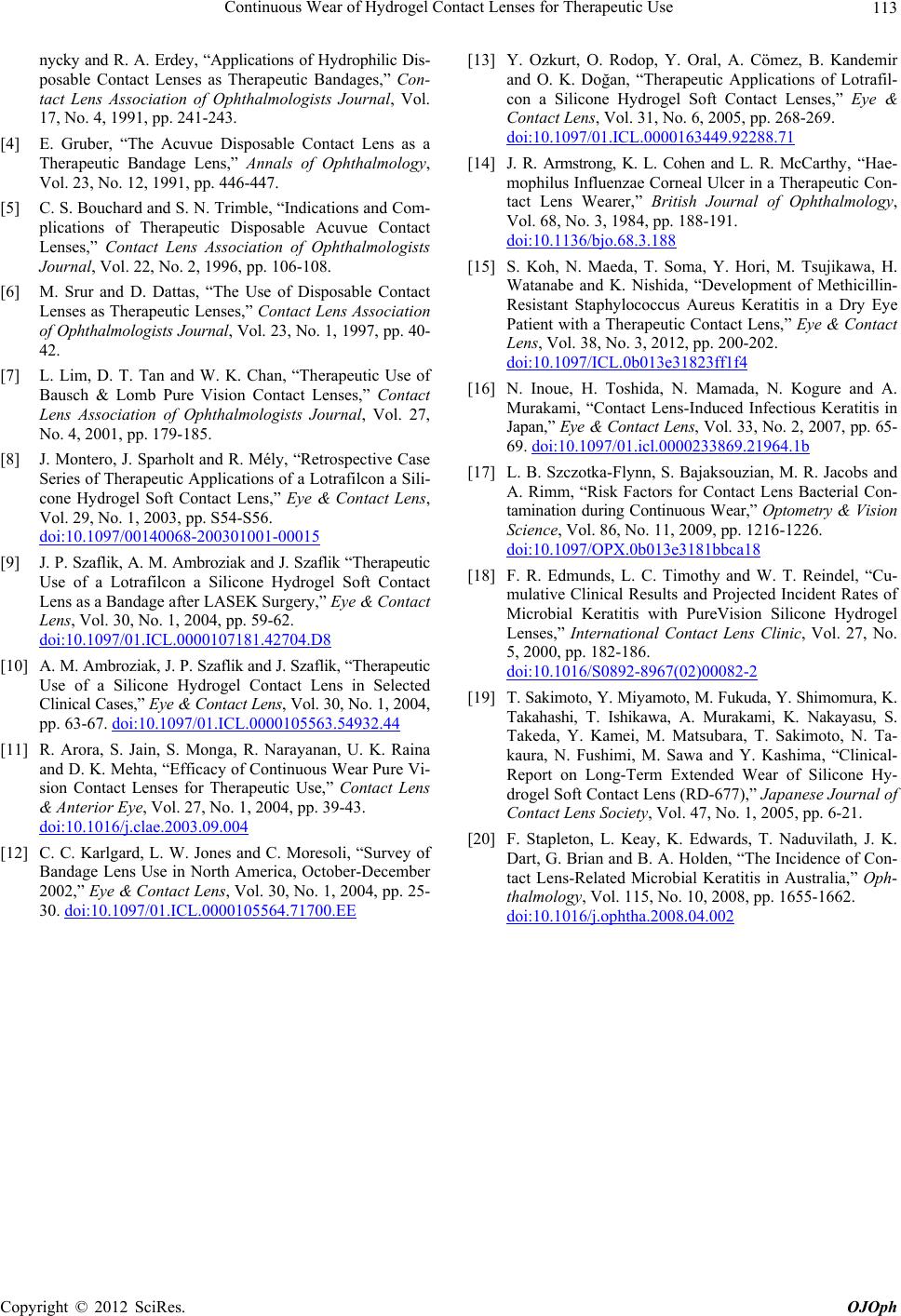
Continuous Wear of Hydrogel Contact Lenses for Therapeutic Use 113
nycky and R. A. Erdey, “Applications of Hydrophilic Dis-
posable Contact Lenses as Therapeutic Bandages,” Con-
tact Lens Association of Ophthalmologists Journal, Vol.
17, No. 4, 1991, pp. 241-243.
[4] E. Gruber, “The Acuvue Disposable Contact Lens as a
Therapeutic Bandage Lens,” Annals of Ophthalmology,
Vol. 23, No. 12, 1991, pp. 446-447.
[5] C. S. Bouchard and S. N. Trimble, “Indications and Com-
plications of Therapeutic Disposable Acuvue Contact
Lenses,” Contact Lens Association of Ophthalmologists
Journal, Vol. 22, No. 2, 1996, pp. 106-108.
[6] M. Srur and D. Dattas, “The Use of Disposable Contact
Lenses as Therapeutic Lenses,” Contact Lens Association
of Ophthalmolog ists Journal, Vol. 23, No. 1, 1997, pp. 40-
42.
[7] L. Lim, D. T. Tan and W. K. Chan, “Therapeutic Use of
Bausch & Lomb Pure Vision Contact Lenses,” Contact
Lens Association of Ophthalmologists Journal, Vol. 27,
No. 4, 2001, pp. 179-185.
[8] J. Montero, J. Sparholt and R. Mély, “Retrospective Case
Series of Therapeutic Applications of a Lotrafilcon a Sili-
cone Hydrogel Soft Contact Lens,” Eye & Contact Lens,
Vol. 29, No. 1, 2003, pp. S54-S56.
doi:10.1097/00140068-200301001-00015
[9] J. P. Szaflik, A. M. Ambroziak and J. Szaflik “Therapeutic
Use of a Lotrafilcon a Silicone Hydrogel Soft Contact
Lens as a Bandage after LASEK Surgery,” Eye & Contact
Lens, Vol. 30, No. 1, 2004, pp. 59-62.
doi:10.1097/01.ICL.0000107181.42704.D8
[10] A. M. Ambroziak, J. P. Szaflik and J. Szaflik, “Therapeutic
Use of a Silicone Hydrogel Contact Lens in Selected
Clinical Cases,” Eye & Contact Lens, Vol. 30, No. 1, 2004,
pp. 63-67. doi:10.1097/01.ICL.0000105563.54932.44
[11] R. Arora, S. Jain, S. Monga, R. Narayanan, U. K. Raina
and D. K. Mehta, “Efficacy of Continuous Wear Pure Vi-
sion Contact Lenses for Therapeutic Use,” Contact Lens
& Anterior Eye, Vol. 27, No. 1, 2004, pp. 39-43.
doi:10.1016/j.clae.2003.09.004
[12] C. C. Karlgard, L. W. Jones and C. Moresoli, “Survey of
Bandage Lens Use in North America, October-December
2002,” Eye & Contact Lens, Vol. 30, No. 1, 2004, pp. 25-
30. doi:10.1097/01.ICL.0000105564.71700.EE
[13] Y. Ozkurt, O. Rodop, Y. Oral, A. Cömez, B. Kandemir
and O. K. Doğan, “Therapeutic Applications of Lotrafil-
con a Silicone Hydrogel Soft Contact Lenses,” Eye &
Contact Lens, Vol. 31, No. 6, 2005, pp. 268-269.
doi:10.1097/01.ICL.0000163449.92288.71
[14] J. R. Armstrong, K. L. Cohen and L. R. McCarthy, “Hae-
mophilus Influenzae Corneal Ulcer in a Therapeutic Con-
tact Lens Wearer,” British Journal of Ophthalmology,
Vol. 68, No. 3, 1984, pp. 188-191.
doi:10.1136/bjo.68.3.188
[15] S. Koh, N. Maeda, T. Soma, Y. Hori, M. Tsujikawa, H.
Watanabe and K. Nishida, “Development of Methicillin-
Resistant Staphylococcus Aureus Keratitis in a Dry Eye
Patient with a Therapeutic Contact Lens,” Eye & Contact
Lens, Vol. 38, No. 3, 2012, pp. 200-202.
doi:10.1097/ICL.0b013e31823ff1f4
[16] N. Inoue, H. Toshida, N. Mamada, N. Kogure and A.
Murakami, “Contact Lens-Induced Infectious Keratitis in
Japan,” Eye & Contact Lens, Vol. 33, No. 2, 2007, pp. 65-
69. doi:10.1097/01.icl.0000233869.21964.1b
[17] L. B. Szczotka-Flynn, S. Bajaksouzian, M. R. Jacobs and
A. Rimm, “Risk Factors for Contact Lens Bacterial Con-
tamination during Continuous Wear,” Optometry & Vision
Science, Vol. 86, No. 11, 2009, pp. 1216-1226.
doi:10.1097/OPX.0b013e3181bbca18
[18] F. R. Edmunds, L. C. Timothy and W. T. Reindel, “Cu-
mulative Clinical Results and Projected Incident Rates of
Microbial Keratitis with PureVision Silicone Hydrogel
Lenses,” International Contact Lens Clinic, Vol. 27, No.
5, 2000, pp. 182-186.
doi:10.1016/S0892-8967(02)00082-2
[19] T. Sakimoto, Y. Miyamoto, M. Fukuda, Y. Shimomura, K.
Takahashi, T. Ishikawa, A. Murakami, K. Nakayasu, S.
Takeda, Y. Kamei, M. Matsubara, T. Sakimoto, N. Ta-
kaura, N. Fushimi, M. Sawa and Y. Kashima, “Clinical-
Report on Long-Term Extended Wear of Silicone Hy-
drogel Soft Contact Lens (RD-677),” Japanese Journal of
Contact Lens Society, Vol. 47, No. 1, 2005, pp. 6-21.
[20] F. Stapleton, L. Keay, K. Edwards, T. Naduvilath, J. K.
Dart, G. Brian and B. A. Holden, “The Incidence of Con-
tact Lens-Related Microbial Keratitis in Australia,” Oph-
thalmology, Vol. 115, No. 10, 2008, pp. 1655-1662.
doi:10.1016/j.ophtha.2008.04.002
Copyright © 2012 SciRes. OJOph